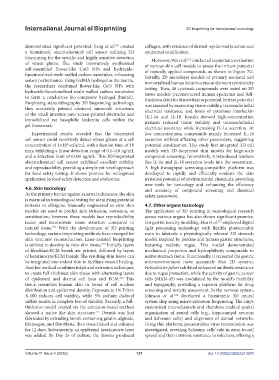Page 129 - v11i4
P. 129
International Journal of Bioprinting 3D bioprinting for translational toxicology
demonstrated significant potential. Jiang et al. created collagen, with evidence of dermal–epidermal junction and
205
a biomimetic electrochemical cell sensor utilizing 3D epidermal stratification.
bioprinting for the specific and highly sensitive detection Moreover, Wei et al. conducted a systematic evaluation
193
of wheat gluten. The study innovatively synthesized of various skin cell models to assess the irritant potential
self-assembled flower-like CuO NPs and hydrazide- of topically applied compounds, as shown in Figure 7G.
functionalized multi-walled carbon nanotubes, enhancing Initially, 2D monolayer models of primary neonatal and
sensor performance. Using GelMA hydrogel as the matrix, immortalized human keratinocytes underwent cytotoxicity
the researchers combined flower-like CuO NPs with testing. Then, 46 cytotoxic compounds were tested on 3D
hydrazide-functionalized multi-walled carbon nanotubes tissue models (reconstructed human epidermis and full-
to form a conductive bio-composite hydrogel (bioink). thickness skin) for skin irritation potential. Irritant potential
Employing stereolithography 3D bioprinting technology, was assessed by measuring tissue viability, transendothelial
they accurately printed clustered microvilli structures electrical resistance, and levels of cytokines interleukin
of the small intestine onto screen-printed electrodes and (IL)-1α and IL-18. Results showed high-concentration
immobilized rat basophilic leukemia cells within the irritants reduced tissue viability and transendothelial
gel framework. electrical resistance while increasing IL-1α secretion. At
Experimental results revealed that the bioprinted low concentrations, compounds mainly increased IL-18
cell sensor could sensitively detect wheat gluten at a cell secretion without affecting other parameters, suggesting
concentration of 1×10 cells/mL with a fixation time of 10 potential sensitization. This study first integrated 2D cell
6
min, exhibiting a linear detection range of 0.1–0.8 ng/mL models with 3D-bioprinted skin models for large-scale
and a detection limit of 0.036 ng/mL. This 3D-bioprinted compound screening. Innovatively, it introduced markers
electrochemical cell sensor exhibited excellent stability like IL-1α and IL-18 secretion levels into the assessment.
and reproducibility, providing a simple yet novel approach A high-throughput screening-compatible platform was
for food safety testing. It shows promise for widespread developed to rapidly and efficiently evaluate the skin
application in food safety detection and evaluation. irritation potential of environmental chemicals, providing
new tools for toxicology and enhancing the efficiency
4.6. Skin toxicology and accuracy of compound screening and chemical
As the primary barrier against external substances, the skin safety assessment.
is essential in toxicological testing for identifying potential
irritants or allergens. Manually engineered in vitro skin 4.7. Other organs toxicology
models are used to predict skin irritation, corrosion, or The application of 3D printing in toxicological research
sensitization; however, these models face reproducibility across various organs has also shown significant promise.
issues and inconsistent tissue structure compared to For gastric toxicity modeling, Hsu et al. employed digital
212
natural tissue. With the development of 3D printing light processing technology with flexible photocurable
209
technology, various bioprinting methods have emerged for resin to fabricate a physiologically relevant 3D stomach
skin structure reconstruction. Laser-assisted bioprinting model, inspired by porcine and human gastric structures,
is utilized to develop in vitro skin tissue. Initially, layers featuring realistic rugae. This model demonstrated
210
of fibroblast/ECM bioink are printed, followed by layers mechanical properties and hydrophilicity comparable to
of keratinocyte/ECM bioink. The resulting skin tissue can native stomach tissue. Functionally, it recreated the gastric
be integrated into rodent skin to facilitate wound healing. microenvironment more accurately than 2D systems:
Another method combines inkjet and extrusion techniques Helicobacter pylori exhibited enhanced antibiotic resistance
to create full-thickness skin tissue with alternating layers due to rugae protection, while the activity of gastric cancer
of epidermal and dermal cell lines and ECM. This cells (MKN-45) was modulated by the model’s flexibility
123
tissue resembles human skin in terms of cell nucleus and topography, providing a superior platform for drug
distribution and epidermal density. Exposure to 1% Triton screening and toxicity assessment. In the nervous system,
X-100 reduces cell viability, while 5% sodium dodecyl Johnson et al. developed a biomimetic 3D neural
164
sulfate results in complete loss of viability. Recently, a full- system chip using micro-extrusion bioprinting. The chip’s
thickness model created via the extrusion-based method customized microchannels and chambers enabled spatial
showed a native like skin structure. Dermis was first organization of neural cells (e.g., hippocampal neurons
211
fabricated by extruding bioink containing gelatin, alginate, and Schwann cells) and alignment of axonal networks.
fibrinogen, and fibroblasts, then cross-linked and cultured Using this platform, pseudorabies virus transmission was
for 12 days. Subsequently, an epidermal keratinocyte layer investigated, revealing Schwann cells’ role in axon-to-cell
was added. By Day 26 of culture, the dermis produced spread and their intrinsic resistance to infection, offering a
Volume 11 Issue 4 (2025) 121 doi: 10.36922/IJB025210209

